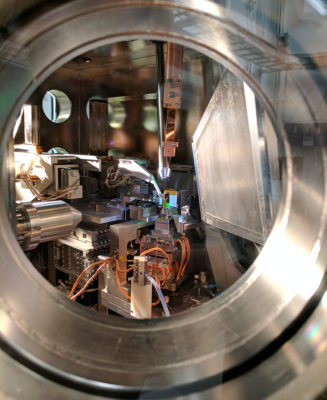From pv magazine International.
Researchers at the University of California San Diego have been able to explain how adding small amounts of cesium or rubidium salt to perovskite-based solar cells can increase performance by around 2%.
According to the paper Homogenized halides and alkali cation segregation in alloyed organic-inorganic perovskites –published in Science – the addition of alkali metal to lead-halide perovskites was a well-known process to increase performance, but no explanation of why this was possible was available.
The discovery, made by a research team led by scientists from the University of California San Diego and MIT, could rapidly advance work to identify the perfect mix of compounds and elements in a perovskite layer for use in solar cells. Until now, researchers have been limited to trial and error in identifying the solar power potential of new perovskites, which have a three-part crystal structure composed of three from a long list of candidate materials.
The U.S. team used high-intensity X-ray imaging techniques to understand exactly how small proportions of cesium and rubidium salt acted as a booster to cell yield.
“By looking at the composition within the perovskite material, we can see how each individual element plays a role in improving the performance of the device,” said research co-author Yanqi Grace Luo. The most important contribution of the salts, the research team claim, is that they determine more even distribution of halide atoms within the perovskite. “We found that uniformity in the chemistry and structure is what helps a perovskite solar cell operate at its fullest potential,” said research coordinator David Fenning. “Any heterogeneity in that backbone is like a weak link in the chain.”
Dead zones mitigated
Rubidium and cesium, the scientists added, improve cell performance in relation to microscopic inactive “dead zones” in perovskite cells – which suck in and retain electrons from other regions, resulting in loss of current and voltage which is detrimental for device yield.
When attached to the two salts, however, the dead zones did not notably affect performance, although there was some current loss. “This shows how robust these materials are but also that there’s even more opportunity for improvement,” said the researchers.
As recent research has demonstrated, the number of chemicals and materials being used to improve performance of perovskite solar devices has constantly increased. The list includes, among others, Cesium-gold-iodide; lead-free perovskites; halide double perovskites; manganese; potassium; and methylammonium, lead and iodide.
This content is protected by copyright and may not be reused. If you want to cooperate with us and would like to reuse some of our content, please contact: editors@pv-magazine.com.









2 comments
By submitting this form you agree to pv magazine using your data for the purposes of publishing your comment.
Your personal data will only be disclosed or otherwise transmitted to third parties for the purposes of spam filtering or if this is necessary for technical maintenance of the website. Any other transfer to third parties will not take place unless this is justified on the basis of applicable data protection regulations or if pv magazine is legally obliged to do so.
You may revoke this consent at any time with effect for the future, in which case your personal data will be deleted immediately. Otherwise, your data will be deleted if pv magazine has processed your request or the purpose of data storage is fulfilled.
Further information on data privacy can be found in our Data Protection Policy.